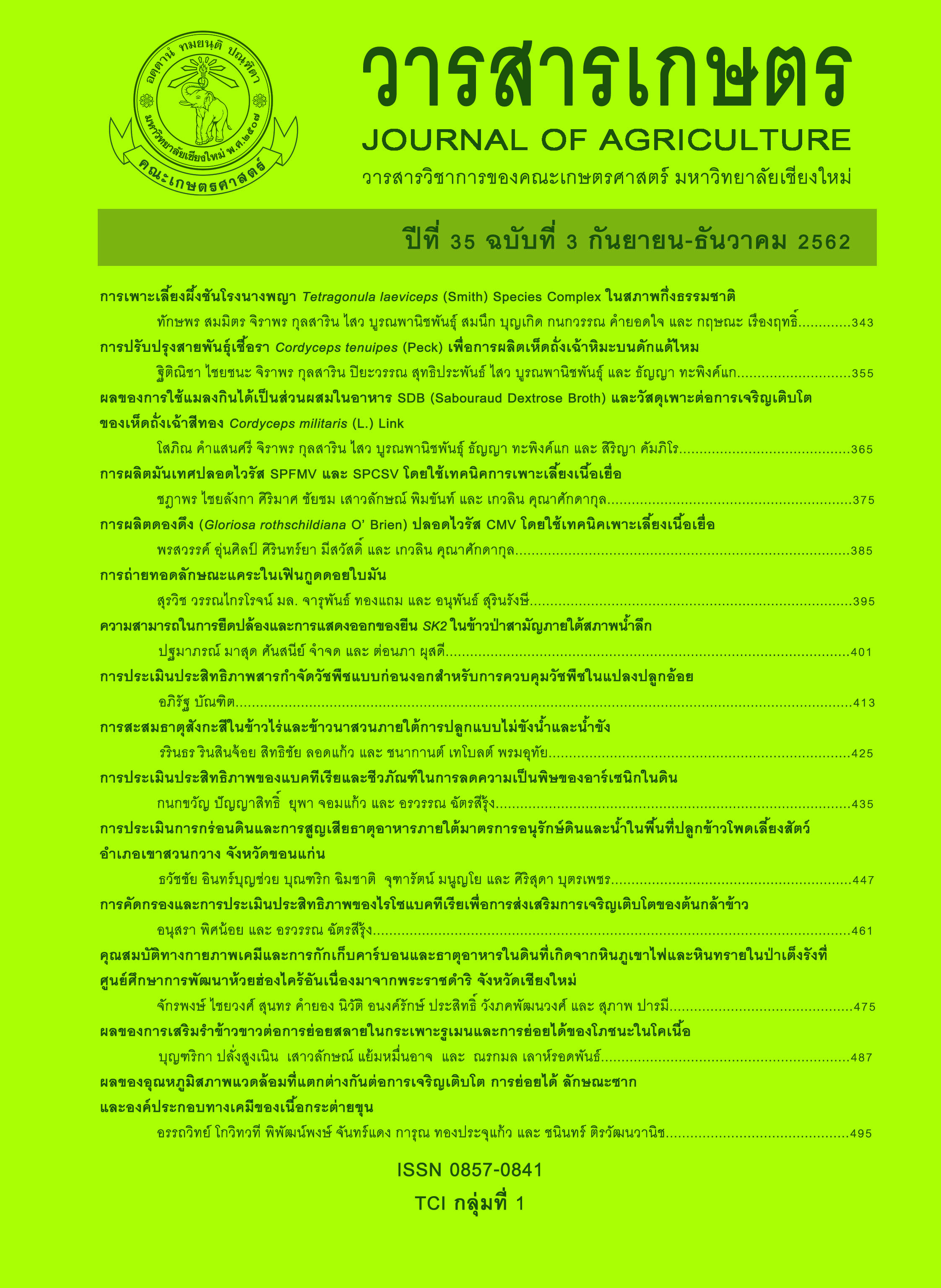Internode Elongation Ability and <I>SK2</I> Gene Expression in Common Wild Rice Under Deep Water
Main Article Content
Abstract
Common wild rice is an important genetic resource since its adaptability to inappropriate environments such as floods or drought conditions. The objective of this study was to evaluate the internode elongation ability and the expression of SK2 gene of common wild rice of Lamphun (WLP), Chiang Mai (WCM) and Roi Et (WRE) and Surin (WSR). The experiment was conducted in randomized complete block design (RCBD) with 3 replications. At sixty days old seeding, wild rice plants were submerged in the cement pot with water level up to 90% of the wild rice plant height in the deep water treatment for 14 day. Internode elongation ability were determined by recording of culm length, number of node and internode length. The results showed that the highest culm length, the highest number of node (3 nodes) and the highest internode elongation at internode 2, 3 and 4 (11.0, 7.6 and 2.9 cm, respectively). Considering the expression levels of SK2 gene, the WLP illustrated the highest expression level. Positive correlations between culm length, internode elongation and the expression of SK2 were found. Taken together, the results of this study showed that SK2 gene is involved in response to deep water by internode elongation. The present research can be used as a basic information in selecting common wild rice germplasm for deep water rice breeding program.
Article Details
References
Anandan, A., S.K. Pradhan, S.K. Das, L. Behera and G. Sangeetha. 2015. Differential responses of rice genotypes and physiological mechanism under prolonged deepwater flooding. Field Crops Research 172: 153-163.
Choi, D. 2011. Molecular events underlying coordinated hormone action in submergence escape response of deepwater rice. Journal of Plant Biology 54(6): 365-372.
Hattori, Y., K. Nagai and M. Ashikari. 2011. Rice growth adapting to deepwater. Current Opinion in Plant Biology 14(1): 100-105.
Hattori, Y., K. Nagai, S. Furukawa, X.J. Song, R. Kawano, H. Sakakibara and M. Ashikari. 2009. The ethylene response factors SNORKEL1 and SNORKEL2 allow rice to adapt to deep water. Nature 460(7258): 1026-1030.
Kihara, H., T.C. Katayama and K. Tsunewaki. 1962. Floating habit of 10 strains of wild and cultivated rice. Japanese Journal of Genetics 37(1): 1-9.
Mohapatra, P.K., B.B. Panda and E. Kariali. 2011. Plasticity of tiller dynamics in wild rice Oryza rufipogon Griff.: A strategy for resilience in suboptimal environments. International Journal of Agronomy, Article ID 543237, doi: 10.1155/2011/543237.
Morishima, H., Y. Sano and H.I. Oka. 1984. Differentiation of perennial and annual types due to habitat conditions in the wild rice Oryza perennis. Plant Systematics and Evolution 144(2): 119-135.
Nagai, K., Y. Hattori and M. Ashikari. 2010. Stunt or elongate? Two opposite strategies by which rice adapts to floods. Journal of Plant Research 123(3): 303-309.
Okishio, T., D. Sasayama, T. Hirano, M. Akimoto, K. Itoh and T. Azuma. 2014. Growth promotion and inhibition of the Amazonian wild rice species Oryza grandiglumis to survive flooding. Planta 240(3): 459-469.
Punyalue, A. 2006. Characterization of common wild rice populations from main rice growing regions of Thailand. M.S. Thesis. Chiang Mai University, Chiang Mai. 76 p. (in Thai)
Schneider, C. A., W.S. Rasband and K.W. Eliceiri. 2012. NIH Image to ImageJ: 25 years of image analysis. Nature Methods 9(7): 671-675.
Singh, A., E.M. Septiningsih, H.S. Balyan, N.K. Singh and V. Rai. 2017. Genetics, physiological mechanisms and breeding of flood-tolerant rice (Oryza sativa L.). Plant and Cell Physiology 58(2): 185-197.
Vaughan, D. A. 1994. The Wild Relatives of Rice: A Genetic Resources Handbook. International Rice Research Institute, Los Baños. 148 p.


